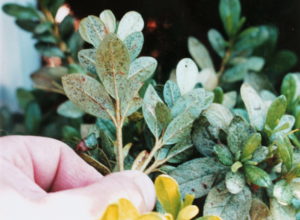Bugged by Bugs? Plant More Plants
August 27th, 2019
I wrote a garden column for the Patriot-News a few years ago on a talk that University of Maryland entomologist Dr. Michael Raupp did at a plant conference.
He made the interesting argument that bugs are a healthy part of any ecosystem (including home gardens) and that the key to keeping them from defiling your plants is not to spray but to plant more plants.
Raupp’s advice is just as timely today as it was then. So if you’re fed up with bug damage by this point in the growing season, here’s what I wrote…
Frustrated by the many bugs eating your measly few plants?
Your best bet isn’t to reach for the sprayer.
It’s to plant more plants.
That bit of seemingly backward logic comes not from a plant-seller but from one of America’s top bug guys, University of Maryland entomologist Dr. Michael Raupp.
Raupp, who moonlights as bug consultant for the TV show “Bones,” has spent much of his career trying to figure out why bugs behave the way they do in home landscapes.
His main conclusion: plant-damaging bugs are winning because we’ve largely wiped out the other bugs that would’ve controlled them.
We’ve done that in two main ways.
One is by getting rid of naturally balanced habitats and replacing them with office buildings, parking lots, shopping malls, and housing developments.
The “landscapes” we put back in are woefully non-diverse – often amounting to little more than lawns, yews, azaleas, and maybe a maple tree or two.
“It’s hard to have plant diversity with asphalt and concrete,” Raupp said.
What happens in a diverse landscape is that the population of beneficial insects goes way up, and those bugs start knocking back the pests without us even realizing it.
Raupp knows this because he’s counted.
He’s studied, for example, what happens to azalea bushes when they’re in a plant-shy environment compared to ones in a plant nut’s diverse yard.
Solitary azaleas get pummeled by lace bugs – the No. 1 azalea pest.
Why? Because plant-challenged yards don’t have nearly the lace-bug-eating assassin bugs, predator mites, and green lacewings that are policing the plant nut’s place.
“In simple landscapes, there are hundreds of times more lace bugs than in a complex landscape,” Raupp says.
Well endowed landscapes “become reservoirs of these beneficial insects,” he adds. “You get more bang for your buck in a complex habitat that’s loaded with natural enemies.”
The second problem is how we view crawly things in our yards.
Our first instinct is usually to spray them in case it’s a bug that’ll eat a plant – or worse yet, get in the house.
Raupp says that’s counter-productive because many insecticides kill a wide range of bugs without regard to whether they help us or annoy us.
That’s particularly bad news for beneficial insects.
When bug populations begin to rebound after a spray-fest (you’ll seldom kill everything), the pests, as a rule, come back first and faster.
It makes sense. Without a food source (i.e. the pests), the beneficials would have trouble repopulating. And so the food has to come first.
“A healthy landscape is a landscape with pests in it,” Raupp contends.
He adds that rampant spraying also kills bees, birds, butterflies, and other non-target wildlife that we depend on for pollination.
The obvious answer, Raupp says, is to make our landscapes more diverse and to drop the “spray-just-in-case” mentality.
Native plants are especially useful since those are ones most familiar to and useful to our native beneficial bugs, he says.
But adding a wide variety of all kinds of flowering plants is the bigger goal.
“You’ve got to provide flowering plants in your landscape year round,” Raupp says. “When (beneficials) aren’t feeding on meat, they’re feeding on flowers.”
In other words, plant and they will come. Plant more, and more will come. And pest problems magically will go down instead of up.









